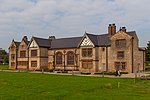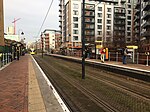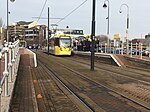St Clement's Church, Ordsall
19th-century Church of England church buildingsAnglican Diocese of ManchesterChurch of England church buildings in Greater ManchesterChurches completed in 1878Gothic Revival architecture in Greater Manchester ... and 4 more
Gothic Revival church buildings in EnglandGrade II listed churches in the City of SalfordPaley and Austin buildingsUse British English from September 2013

St Clement's Church is a Grade II listed building on Hulton Street, Ordsall, Salford, Greater Manchester, England. It is an active Anglican parish church in the Anglican Diocese of Manchester.
Excerpt from the Wikipedia article St Clement's Church, Ordsall (License: CC BY-SA 3.0, Authors, Images).St Clement's Church, Ordsall
Hulton Street, Salford Ordsall
Geographical coordinates (GPS) Address External links Nearby Places Show on map
Geographical coordinates (GPS)
| Latitude | Longitude |
|---|---|
| N 53.4724 ° | E -2.276 ° |
Address
St Clement
Hulton Street
M5 3WQ Salford, Ordsall
England, United Kingdom
Open on Google Maps








